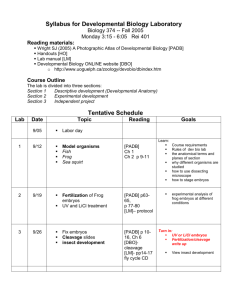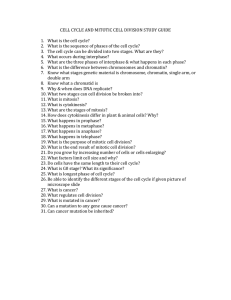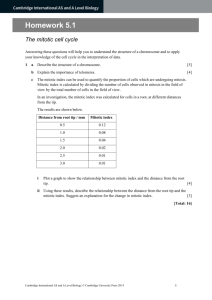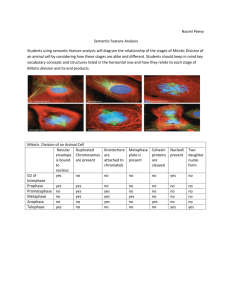Mitotic activity during somite segmentation Anatomy and Embryology
advertisement
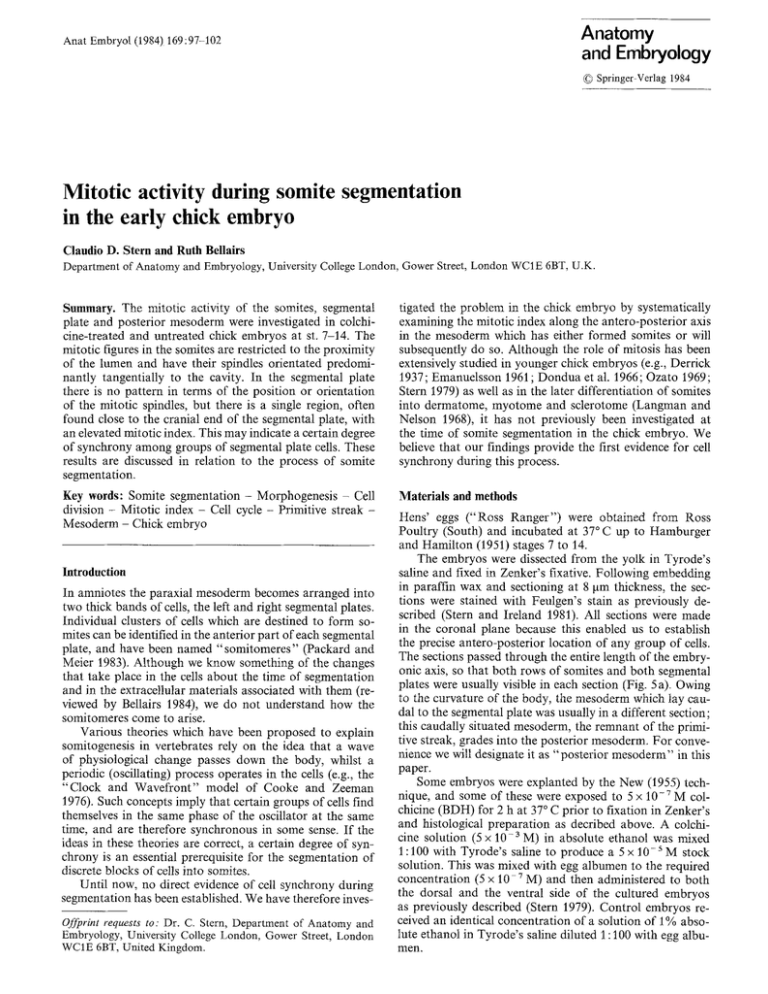
Anatomy and Embryology Anat Embryo[ (1984) 169 : 97-102 9 Springer-Verlag 1984 Mitotic activity during somite segmentation in the early chick embryo Claudio D. Stern and Ruth BeHairs Department of Anatomy and Embryology, University College London, Gower Street, London WC1E 6BT, U.K. Summary. The mitotic activity of the somites, segmental plate and posterior mesoderm were investigated in colchicine-treated and untreated chick embryos at st. 7-14. The mitotic figures in the somites are restricted to the proximity of the lumen and have their spindles orientated predominantly tangentially to the cavity. In the segmental plate there is no pattern in terms of the position or orientation of the mitotic spindles, but there is a single region, often found close to the cranial end of the segmental plate, with an elevated mitotic index. This may indicate a certain degree of synchrony among groups of segmental plate cells. These results are discussed in relation to the process of somite segmentation. tigated the problem in the chick embryo by systematically examining the mitotic index along the antero-posterior axis in the mesoderm which has either formed somites or will subsequently do so. Although the role of mitosis has been extensively studied in younger chick embryos (e.g., Derrick 1937 ; Emanuelsson 1961 ; Dondua et al. 1966; Ozato 1969; Stern 1979) as well as in the later differentiation of somites into dermatome, myotome and sclerotome (Langman and Nelson 1968), it has not previously been investigated at the time of somite segmentation in the chick embryo. We believe that our findings provide the first evidence for cell synchrony during this process. Key words: Somite segmentation - Morphogenesis - Cell division - Mitotic index - Cell cycle - Primitive streak Mesoderm - Chick embryo Materials and methods Introduction In amniotes the paraxial mesoderm becomes arranged into two thick bands of cells, the left and right segmental plates. Individual clusters of cells which are destined to form somites can be identified in the anterior part of each segmental plate, and have been named "somitomeres" (Packard and Meier 1983). Although we know something of the changes that take place in the cells about the time of segmentation and in the extracetlular materials associated with them (reviewed by Bellairs 1984), we do not understand how the somitomeres come to arise. Various theories which have been proposed to explain somitogenesis in vertebrates rely on the idea that a wave of physiological change passes down the body, whilst a periodic (oscillating) process operates in the cells (e.g., the "Clock and Wavefront" model of Cooke and Zeeman 1976). Such concepts imply that certain groups of cells find themselves in the same phase of the oscillator at the same time, and are therefore synchronous in some sense. If the ideas in these theories are correct, a certain degree of synchrony is an essential prerequisite for the segmentation of discrete blocks of cells into somites. Until now, no direct evidence of cell synchrony during segmentation has been established. We have therefore invesOffprint requests to: Dr. C. Stern, Department of Anatomy and Embryology, University College London, Gower Street, London WC1E 6BT, United Kingdom. Hens' eggs ("Ross Ranger") were obtained from Ross Poultry (South) and incubated at 37~ up to Hamburger and Hamilton (1951) stages 7 to 14. The embryos were dissected from the yolk in Tyrode's saline and fixed in Zenker's fixative. Following embedding in paraffin wax and sectioning at 8 gm thickness, the sections were stained with Feulgen's stain as previously described (Stern and Ireland 1981). All sections were made in the coronal plane because this enabled us to establish the precise antero-posterior location of any group of cells. The sections passed through the entire length of the embryonic axis, so that both rows of somites and both segmental plates were usually visible in each section (Fig. 5 a). Owing to the curvature of the body, the mesoderm which lay caudal to the segmental plate was usually in a different section; this caudally situated mesoderm, the remnant of the primitive streak, grades into the posterior mesoderm. For convenience we will designate it as "posterior mesoderm" in this paper. Some embryos were explanted by the New (1955) technique, and some of these were exposed to 5 x 10 .7 M colchicine (BDH) for 2 h at 37 ~ C prior to fixation in Zenker's and histological preparation as decribed above. A colchicine solution (5x 10 - 3 M) in absolute ethanol was mixed 1:100 with Tyrode's saline to produce a 5 x 1 0 - S M stock solution. This was mixed with egg albumen to the required concentration (5 x 10 ~ M) and then administered to both the dorsal and the ventral side of the cultured embryos as previously described (Stern 1979). Control embryos received an identical concentration of a solution of 1% absolute ethanol in Tyrode's saline diluted 1 : 100 with egg albumen. 98 The sections were scored using a Wild standard upright microscope, with a 100 x oil immersion objective (NA 1.25), J0 x " K " eyepieces, bright field optics with a 1.30 condenser (0.65 NA) and green filters (Hoya G [XI] and G [XO]) placed above the field diaphragm. One eyepiece was fitted with a micrometer with a circular grid, which at the magnification used had an apparent maximum diameter of 119 gm. This circle was subdivided into squares, each of which measured 11.8 gm on a side. Each 119 ~tm diameter field had an area of 11,122 gm 2 (and, since sections were 8 gm thick, a volume of 88,976 gm3). The embryos were scored for mitotic figures, proceeding in an antero-posterior direction. Alternate sections were examined, to avoid the possibility of overlap between adjacent sections. The parameters measured in each field were: (a) total cell number and (b) size of field (if less than the 119 gm diameter), (c) number of total mitotic figures, and number of each phase (classed into prophase, metaphase, anaphase, telophase), (d) orientation of the mitotic spindle (classified into radial or tangential to the lumen of the somite or dorso-ventral to the plane of the section for the somites, and into antero-posterior, dorso-ventral or medio-lateral for the segmental plate and the tail-bud regions), and (e) position of the mitotic figures within the somites (this was determined by recording the position of each mitotic figure on a schematic drawing of a somite for each section). All scoring was carried out by one of us (C.D.S.) so as to maintain a consistency in the criteria selected. Photographs were taken using a Zeiss IM35 inverted microscope fitted with an Olympus O M I 0 camera. The techniques used have been previously described (Stern and Ireland 1981). In order to compare the sizes of somites formed in colchicine-treated and control embryos, the index suggested by Bellairs and Veini (1983) was used. This consists of the product of the antero-posterior diameter by the medio-lateral diameter of each somite, as viewed from the dorsal side of the embryo, and is expressed in lainz of apparent dorsal cross-sectional area. This index provides a better estimate of somite size than a simple maximum diameter measurement, since somites are rarely perfectly spherical. Results a) Mitotic rates, orientation of spindles and regional variations The mitotic indices of the somites, segmental plates and the mesoderm posterior to the segmental plate were determined in 14 embryos at Hamburger and Hamilton (1951) stages 9, 12 and 13. The average mitotic indices were 4.74-t-2.52 (S.D.) for the somites (432 somite sections), 6.49-t-3.83 (S.D.) for the segmental plate (n= 171 fields of 11,122 gm 2 cross-sectional area) and 6.37_+ 3.19 (S.D.) (n= 28 fields) for the posterior mesoderm. These differences are not statistically significant. Within the somites, mitotic figures were restricted to nuclei immediately adjacent to the lumen of each somite, but there were no somites or regions of somites which had significantly higher or lower mitotic indices than the remainder. The orientation of the spindles was related to the position of the mitotic figures with respect to the lumen. In a series of 432 fields (1475 spindles recorded), 355 spin- 0/0 t00- 75- 2477 50- 1669 342 P M A 252 T Fig. 1. Bar diagram of the distribution of mitotic figures into the phases of mitosis (classified into P prophase; M metaphase; A anaphase; T telophase). The numbers over each class represent the number of mitotic figures counted. The ordinate represents the frequency of each phase in % MI% SOMITE ~, 1'2 (8 2'4 FIELD N ~ Fig. 2. Mitotic index along the axis of 2 embryos at stage 12. The vertical line shows the position of the cranial end of the segmental plate. Note the position of the peak close to the anterior end of the segmental plate. The bars represent the standard error of the mean (n = 7 sections) dies (24%) were orientated radially with respect to the lumen and 1120 (76%) were arranged tangentially. The distribution of mitotic figures with respect to the phases of mitosis is shown in Fig. 1. In the segmental plate, neither the position of the mitotic figures within each counted field nor their orientation appeared to correspond with any discernible pattern. However, a substantial proportion of the embryos displayed a marked peak of mitotic index at some level within the segmental plate. This peak was generally the region of highest mitotic index in the somite/segmental plate mesoderm of the embryo. Most often the peak was found either at or immediately posterior to the cranial end of the segmental plate (Fig, 2), but in some cases it could be found some 3M fields (350-500 ~tm) behind the cranial end (Fig. 3). The peaks in the left and right segmental plates were at the same level in each embryo. No embryos were found which displayed more than one peak within any one side. (In a few embryos the peak was discovered at one side only, though it may be significant that in each of these specimens the coronal sections were not cut perfectly symmetrically which may have resultet in some masking of the data.) The difference between the mitotic rate of this region and adjacent regions was sometimes so marked that the presence 99 MI% 12 9 6 3 0 0 4. 8 1~2 FIELD N~ Fig. 3. Mitotic index along the axis of an embryo (both sides) at stage 9. The vertical line shows the position of the cranial end of the segmental plate. Note the position of the peak 4 fields (about 500 gm) behind the cranial end of the segmental plate. The bars represent the standard error of the mean (n = 4 sections) of this peak could be established by direct observation (Fig. 4): peaks as high as 22% were recorded in some embryos. No correlation was found between either the position or the size of the peak and the stage of the embryo. The position of the peak did not necessarily correspond to the position of the group of cells destined to form the next somite. No pattern in the orientation or in the position of the spindles was discernible in the posterior mesoderm. b) Colchicine treated embryos A total of 10 embryos between stages 7 and 12 were exposed to 5 x 10-7 M colchicine for 2 h in New (1955) culture, and a further 5 embryos grown by the New (1955) technique in the presence of ethanol/Tyrode's in egg albumen for 2 h were used as controls. No differences in the mitotic indices, position or orientation of mitotic spindles were found between cultured embryos used as controls in this experiment and un-cultured embryos fixed directly after explantation (see previous section). In the presence of colchicine, the mean mitotic index rose to 8.61 _+4.23 (S.D.) (n= 144 somite sections) for the somites, 8.48 ___5.18 (S.D.) (n = 77 fields) for the segmental plate and 9.49 + 4.13 (S.D.) (n = 12 fields) for the posterior mesoderm. These differences are not statistically significant. Assuming that the colchicine exposure has arrested all the cells which entered mitosis within the 2 h exposure period, these values allow us to make a rough estimate for the average cell cycle time of 23 h. The distribution into the phases of mitosis is shown in Fig. 6. Although there is a predominance of metaphases, there is a small number of later phases of mitosis present in these colchicine-treated embryos. The orientation of spindles, their position with respect to the lumen of the somites and the presence of a peak (Fig. 5 b) in the segmental plate were identical with those of control and uncultured embryos. In a separate series 14 embryos were cultured by the New (1955) technique for 2 h in the presence of 1 0 - 6 M colchicine and 15 control embryos were cultured for a similar length of time in ethanol/Tyrode's/albumen. The dimensions of the somites were measured according to the method of Bellairs and Veini (1983), The embryos were initially at stage 8-9. The experimental as well as the control embryos made 1-2 pairs of somites of normal appearance during the 2 h culture. No significant differences were detected between the sizes of the newly formed somites during the culture period in the two groups. Similarly, no differences were found between the two groups in the sizes of the somites which had already formed before the culture period, or in the sizes of all the somites present (i.e., the ah'eady formed ones and the newly formed ones taken together). Fig. 4. Light micrograph of anterior end of the segmental plate of an embryo at stage 9. Note the visible discrete region of high mitotic index, x 400 100 Fig. 5. a Low power micrograph of a coronal section through a 14 somite embryo typical of those counted in this investigation. The embryo had been treated with colchicine for 2 h x 30. b Enlargement of the region indicated in Fig. 5 a, showing the position of the peak of high mitotic index in this embryo, x 400 Five experimental and four control embryos from this group were cultured for a b o u t 18 h in the presence of either colchicine or control solution. Both experimental and control embyros m a d e somites of n o r m a l appearance during this period, although other embryonic processes were somewhat affected by the presence o f colchicine, especially the expansion of the area opaca (see Downie 1976 and Stern and Bellairs 1984). 100" 1 761 7 5 84 50" 25 452 P Discussion M 77 24 A T Fig. 6. Bar diagram of the distribution of mitotic figures into the phases of mitosis after exposure to colchicine for 2 h. The numbers over each class represent the number of mitotic figures counted. The ordinate represents the frequency of each phase in %. P, M, A, T, as for Fig. 1 Our main finding has been that there is a high peak o f mitosis within the segmental plate mesoderm, and that this peak tends to occur within the anterior (cranial) half of the segmental plate. The precise location o f the peak varies somewhat from one embryo to another so that it is not possible to correlate it with, say, the next group of cells which will segment 101 or even with the one after that. Nevertheless, it can be concluded that the peak of mitotic activity occurs in cells which will soon afterwards be involved in segmentation. The observation that the peak is located at the same level on the left and right sides of the embryo, suggests that its position is not random. One of the effects of this high peak of mitosis is to raise the mean mitotic index of the segmental plate above that of the somites. Tam (1981) similarly found that in the mouse there was a higher mitotic index in the segmental plate (i.e., in the "pre-segmental mesoderm ", as it is called in mammals) than in the somites. Unfortunately, however, his data was not presented in such a way as to enable us to decide whether or not this was the result of a peak in a limited region or was a general characteristic of the segmental plate. The level of mitosis we have recorded in the peak is remarkably high, up to about 22% in untreated embryos and up to 50% in colchicine-treated embryos. Such high levels have not previously been reported for young chick embryos either by ourselves (Bellairs 1955; Stern 1979) or by others (e.g., Emanueisson 1961 ; Dondua et al. 1966). The finding of these peaks is important because it implies that a certain degree of synchrony exists in the cells in the segmental plate. Synchrony of mitosis has often been noted in cleavage stages of embryos (Detlaff 1964; Gerhart 1980) but is uncommon once differentiation has started. It is possible that this synchrony is established at the time when groups of cells are added to the caudal end of each segmental plate; there is some evidence that they undergo an important step in their determination at this stage (see discussion by Bellairs 1984). It is even possible that these cells possess a common lineage. Indeed, Gearhart and Mintz (1972) who studied somite formation in allophenic mice, put forward the concept that somites consisted of cell clones which had arisen by proliferation of small groups of cells that had become determined at a much earlier stage. Alternatively, it is possible that groups of cells become synchronised during their sojourn in the segmental plate, and that this synchrony is associated with the establishment of somitomeres. Whatever the origin of the synchrony, however, the observation that it always occurs towards the anterior end of the segmental plate in embryos of different stages, permits us to make an important deduction. As segmentation proceeds, the peak of mitosis is experienced by groups of cells which lie further and further posteriorly along the body. Thus a wave of high mitotic activity passes down the body at this time. Synchrony of mitosis may in itself be merely a component of a more fundamental wave of physiological activity. Its importance, however, is that the passage of wavefronts down the antero-posterior axis of the embryo has frequently been involved in theoretical models for the control of somite segmentation (e.g., Cooke and Zeeman 1976; Elsdale and Pearson 1979). Evidence of such waves has been obtained from the heat shock experiments in amphibians (e.g., Cooke and Elsdale 1980) and chicks (Bellairs and Veini 1984). The present findings provide additional supportive evidence for the passage of a physiological wave. Overton (1958) observed " a n unmistakable antero-posterior gradient in mitoses in the trunk region" of the chick embryo at stages 13-15. She also found an "increase in the number of mitotic figures, ..- particularly posteriorly". Although the precise meaning of these statements is not entirely clear from her description, these observations could be consistent with our own findings in this paper. We do not suggest that the peak of mitosis as such plays a significant role in controlling the process of segmentation, other than ensuring that an essential minimum population of cells is present. In other developing systems (e.g. the formation of skeletal elements in the limb bud) a threshold number of cells is necessary if differentiation is to occur (Lewis 1975; Wolpert et al. 1979). In the segmental plate of the chick, however, this threshold is apparently much lower than the normal size of the population, since miniaturised somites can develop even if the amount of somite mesoderm is drastically reduced (Bellairs and Veini 1984; Menkes and Sandor 1977). There is substantial evidence that the cells in the segmental plate are already determined to form somites (see Bellairs 1984) and that they have already begun to assemble into somitomeres (Meier 1979). The rate at which the cells divide therefore has probably little influence on the process of segmentation. It seems likely however that there is a direct correlation with the growth of the individual somitomeres and with the size of the somites which subsequently form from them. A similar conclusion was reached by Tam (1981) for mice embryos. In the present investigation we found no evidence for any region of high mitotic index in the posterior mesoderm. This is in agreement with similar findings by Pasteels (1943) and Gaertner (1949). Another interesting finding in this paper is that the orientation of the mitotic spindles differs greatly in the somites and the segmental plate. Thus in the somites, the mitotic figures lie close to the lumen of the somite and their spindles are orientated tangentially to it. In the segmental plate and in the posterior mesoderm however, no orderly pattern could be distinguished. These differences may be correlated with the fact that each somite is an epithelial structure (Hay 1968; Bellairs 1979) with its apical side lining the central lumen. Like other epithelia therefore the cells undergo interkinetic migration, so that the mitotic figures become arranged along the apical side (e.g. Martin 1968). The unsegmented mesoderm, in contrast, is not epithelial, and as a result the mitotic figures are randomly arranged. Acknowledgements. The present study was supported by a grant from the Science and Engineering Research Council to R.B. We are grateful to Dr. E.J. Sanders for reading the manuscript and to Mrs. Rosalyn Cleevely for valuable technical assistance. References Bellairs R (1955) Studies on the development of the foregut in the chick embryo. III. Mesodermal induction and mitosis. J Embryol Exp Morphol 5:340-349 Bellairs R (1979) The mechanism of somite segmentation in the chick embryo. J Embryol Exp Morphol 51 : 22%243 Bellairs R (1984) A new theory on control of somite formation in the chick embryo. In: Lash J (ed.) "Developmental mechanisms. Normal and abnormal" Alan R. Liss, New York (in press) Bellairs R, Veini M (1983) An experimental analysis of somite segmentation in the chick embryo. J Embryol Exp Morphol 33:93-108 Bellairs R, Veini M (1984) Experimental analysis of control mechanisms in somite segmentation in avian embryos. II. Reduction of material at the gastrula stage. J Embryol Exp Morphol (in press) 102 Cooke J, Elsdale (1980) Somitogenesis in amphibian embryos. III. Effects of ambient temperature and of developmental stage upon pattern abnormalities that follow short temperature shocks. J EmbryoI Exp Morphol 58:107-1 ~8 Cooke J, Zeeman C (1976) A clock and wavefront model for control of the number of repeated structures during animal morphogenesis. J Theor Biol 58:455 476 Derrick GE (1937) An analysis of the early development of the chick embryo by means of the mitotic index. J Morphol 61 : 257-284 Detlaff TA (1964) Cell divisions, duration of interkinetic states and differentiation in early stages of development. Adv Morphogen 3 : 326-362 Dondua AK, Efremov VI, Krichinskaya EB, Nikolaeva IP (1966) Mitotic index, duration of mitosis and proliferation activity in the early phases of the development of the chick embryo. Acta Biol Hung 17:127-143 Downie JR (1976) The mechanism of chick blastoderm expansion. J Embryol Exp Morphol 35:55%575 Elsdale T, Pearson M (1979) Somitogenesis in amphibian embryos. II. Origins in early embryogenesis of two factors involved in somite specification. J Embryol Exp Morphol 53:245-267 Emanuelsson H (1961) Mitotic activity in chick embryos at the primitive streak stage. Acta Physiol Scand 52:211-233 Gaertner RA (1949) Development of the posterior trunk and tail of the chick embryo. J Exp Zool i11:157-174 Gearhart JD, Mintz B (1972) Clonal origins of somites and their muscle derivatives: evidence from allophenic mice. Dev Biol 29 : 27-37 Gerhart JC (1980) Mechanisms regulating pattern formation in the amphibian egg and early embryo. In: Goldberger RF (ed) Biological regulation and development. VoI. 1 Molecular organization and cell function. Plenum Press, New York Hamburger V, Hamilton HL (1951) A series of normal stages in the development of the chick. J Morphol 88:49-92 Hay ED (1968) Organization and fine structure of epithelium and mesenchyme in the developing chick embryo. In: Fleischmajer R, Billingham RE (eds) Epithelial-mesenchymal interactions. Williams & Wilkins, Baltimore Langmau J, Nelson SR (1968) A radioautographic study of the development of the somites in the chick embryo. J Embryol Exp Morphol 19:217-226 Lewis JH (1975) Fate maps and the pattern of cell division. A calculation for the chick wing bud. J Embryol Exp Morphol 33:419-434 Martin AH (1968) Mitotic spindle fibre orientation in the node and streak of the chick embryo. Acta EmbryoI Morphol Exp 10: 207-219 Meier S (1979) Development of the chick embryo mesoblast: Formation of the embryonic axis and establishment of the metameric pattern. Dev Biol 73:25-45 Menkes B, Sandor S (1977) Somitogenesis: regulation potencies, sequence determination and primordial interactions. In: Ede DA, Hinchliffe JR, Balls M (eds) Vertebrate limb and somite morphogenesis. Cambridge University Press New DAT (1955) A new technique for the cultivation of chick embryos in vitro. J Embryol Exp Morphol 3:326-331 Overton J (1958) Effects of colchicine on the early chick blastoderm. J Exp Zool 139:329-347 Ozato K (1969) Cell cycle in the primitive streak and notochord of early chick embryos. Embryologia 10: 297-311 Packard DS, Meier S (1983) An experimental study of the somitomeric organization in the avian segmental plate. Dev Biol 97:191-202 Pasteels J (1943) Prolif6ration et croissance dans la gastrulation et la formation de la queue des vertebr6s. Arch Biol 54:1-51 Stern CD (1979) A re-examination of mitotic activity in the early chick embryo. Anat Embryol 156:319-329 Stern CD, Bellairs R (1984) The roles of node regression and elongation of the area pellucida in the segmentation of somites in avian embryos. (submitted) Stern CD, Ireland GW (1981) An integrated experimental study of endoderm formation in avian embryos. Anat Embryol 163 : 245-263 Tam PPL (1981) The control of somitogenesis in mouse embryos. J Embryol Exp Morphol 65 (Suppl.) : 103-128 Wolpert L, Tickle C, Samford M (1979) The effect of cell killing by X-irradiation on pattern formation in the chick limb. J Embryol Exp Morplaol 50:175-198 Accepted December 2, 1983
